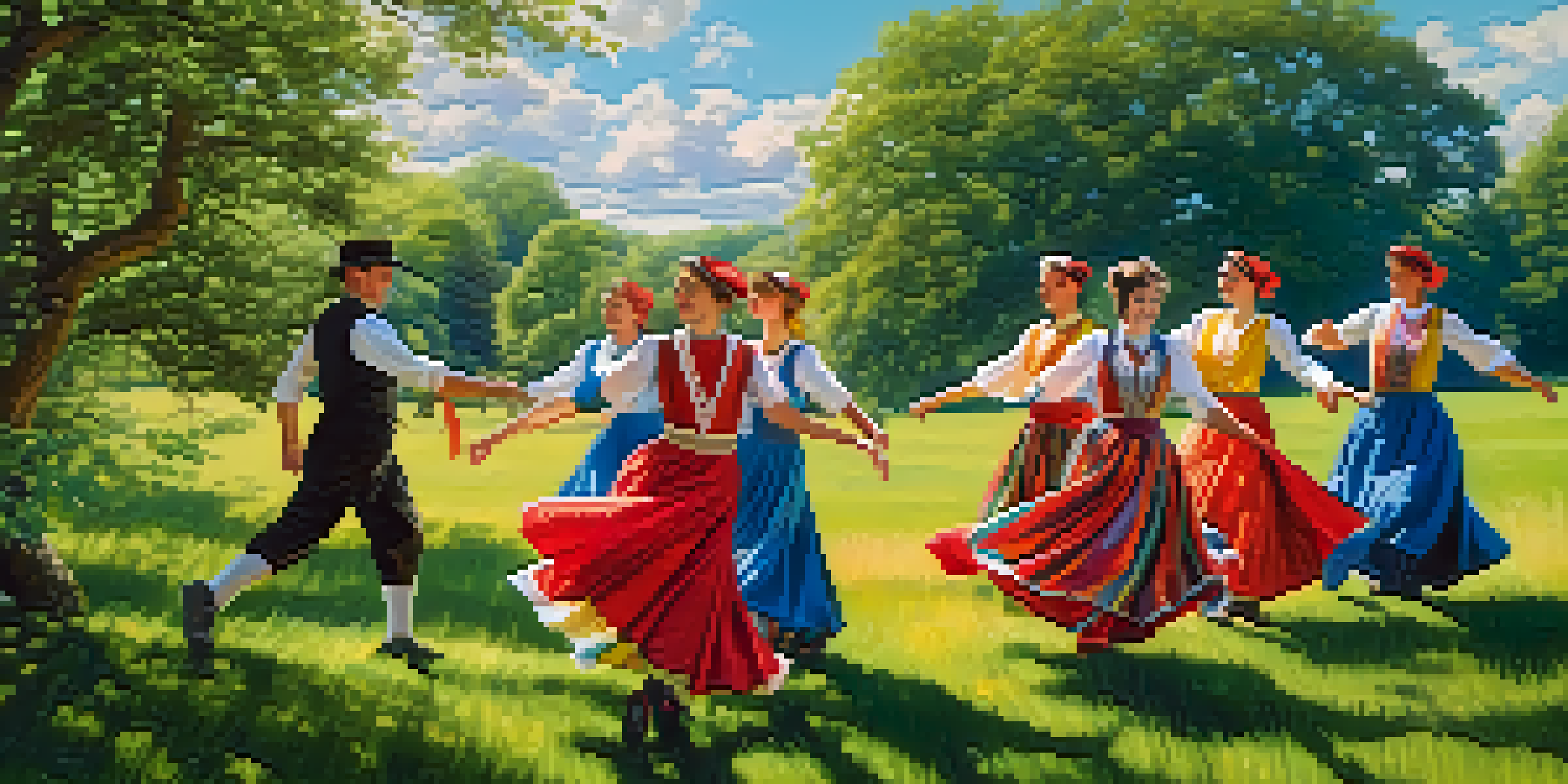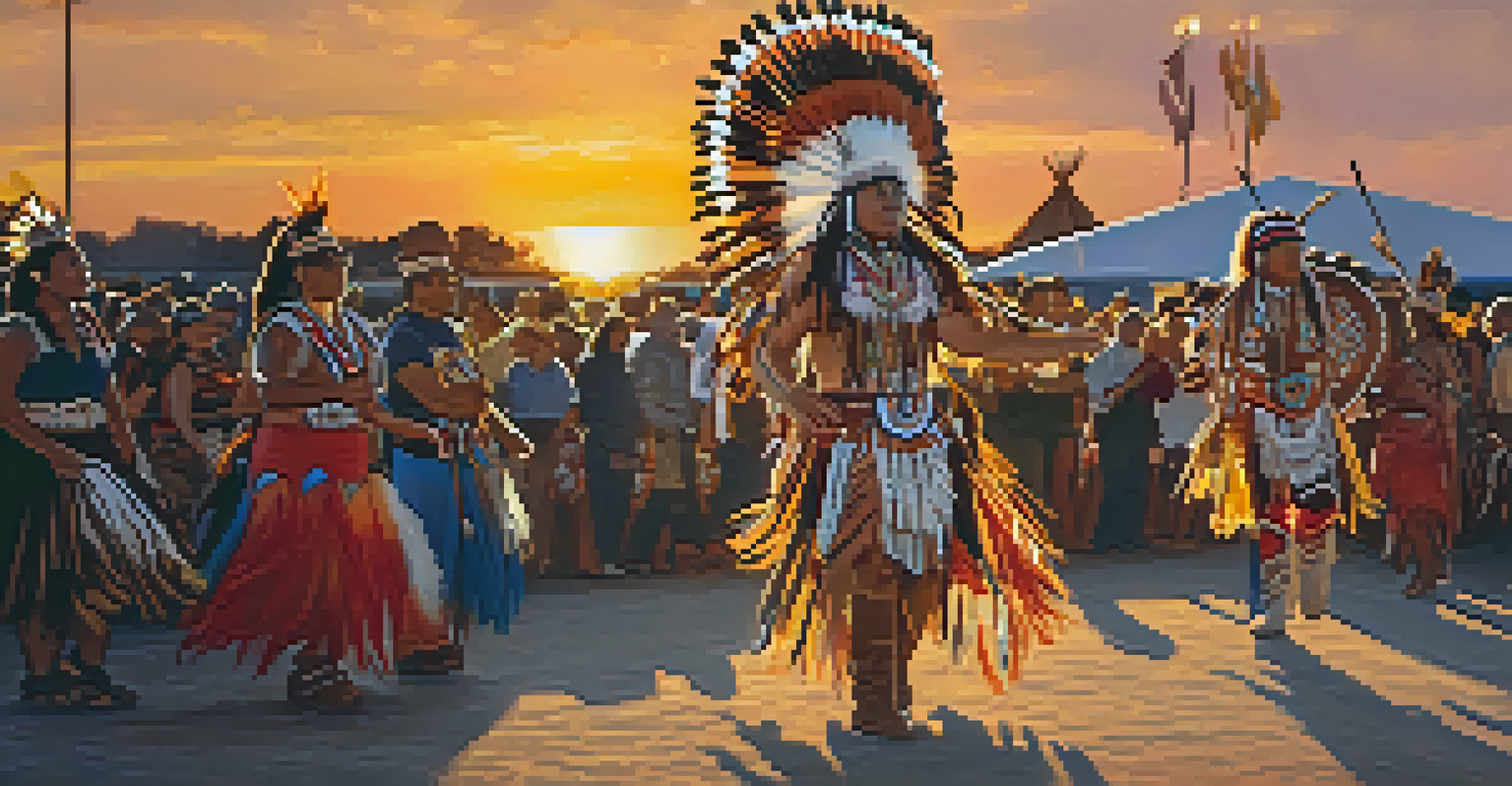The Influence of Folk Dance on Historical Narratives

Understanding Folk Dance as a Storytelling Medium
Folk dance is more than just rhythmic movement; it's a vibrant form of storytelling that captures the essence of a community's culture. Through dance, historical events, social norms, and traditional values are expressed, making it a powerful tool for preserving history. For instance, dances like the Irish jig often depict tales of triumph and struggle, allowing participants and audiences alike to connect with their heritage.
Dance is the hidden language of the soul.
These dances often incorporate elements representing daily life, rituals, or significant historical events, transforming abstract concepts into relatable narratives. As dancers perform, they embody the emotions and experiences of their ancestors, creating a dynamic link between past and present. This connection helps ensure that the stories told through these dances are not forgotten, even as generations change.
Moreover, the communal aspect of folk dance encourages collective memory and reinforces social bonds. As communities gather to dance, they share stories and experiences, fostering a sense of unity and belonging. In this way, folk dance becomes a living narrative, continuously evolving yet rooted in the historical context from which it emerged.
Cultural Preservation Through Dance
Folk dance serves as a vital means of cultural preservation, allowing communities to maintain their identity in a rapidly changing world. Many traditional dances are passed down through generations, often accompanied by specific music, costumes, and stories that enrich their significance. This preservation of cultural practices ensures that the values and beliefs of a community are kept alive and relevant.

For example, the Indigenous powwow dances reflect the rich heritage and spiritual beliefs of Native American communities. Each dance tells a story of resilience and connection to the earth, emphasizing the importance of cultural identity amidst external pressures. By engaging in these dances, participants not only honor their ancestors but also educate others about their unique histories.
Folk Dance as Cultural Storytelling
Folk dance serves as a vibrant medium for storytelling, preserving historical events and cultural values through rhythmic movement.
In this digital age, where globalization can dilute local traditions, folk dance stands as a counterbalance, celebrating diversity and fostering respect for various cultures. It reminds us that each dance has a unique story to tell, one that contributes to the rich tapestry of human history and experience.
Historical Events Reflected in Dance
Many folk dances have roots in significant historical events, acting as living memorials that keep the past alive. For instance, the Polka originated in 19th-century Europe amidst social changes and has since evolved to reflect various historical contexts. Through dance, these events are not only remembered but also reinterpreted, allowing communities to process their histories in a unique way.
Folk culture is a living, breathing entity that grows and evolves just as we do.
In regions affected by conflict, dances often emerge as a form of resistance or resilience. For example, during the Spanish Civil War, dances served as a means of cultural expression and defiance, symbolizing hope and unity in the face of adversity. Such dances encapsulate the emotions surrounding historical turmoil and provide a platform for healing and reflection.
By examining the themes and movements within these dances, we can glean insights into the values and experiences of the people who created them. This exploration deepens our understanding of history, revealing the complex interplay between cultural expression and significant historical moments.
Folk Dance as a Reflection of Social Change
As societies evolve, so too do their folk dances, often reflecting broader social changes and movements. For example, the emergence of women's empowerment has transformed traditional dances, allowing women to take on more prominent roles. This shift not only reshapes the dance itself but also signifies changing attitudes towards gender and equality.
Similarly, the adaptation of folk dance in urban settings illustrates how cultural practices can thrive outside their original contexts. Dances that once served a specific purpose within rural communities now find new meanings in contemporary settings, often blending with modern styles. This fusion creates a dialogue between tradition and innovation, highlighting the adaptability of cultural expressions.
Cultural Preservation Through Dance
By passing down traditional dances, communities maintain their identity and educate others about their unique cultural heritage.
Through these transformations, folk dance becomes a mirror of society, showcasing the hopes, struggles, and aspirations of its people. By engaging with these evolving forms, we gain a deeper appreciation for the resilience of cultural practices and their ability to reflect the changing dynamics of social life.
The Role of Music in Folk Dance Narratives
Music plays an integral role in folk dance, serving as the heartbeat that drives the movement and narrative. Traditional melodies often accompany dances, enhancing their emotional depth and providing context for the stories being told. The rhythms and lyrics can evoke feelings of joy, sorrow, or nostalgia, further enriching the narrative experience.
For instance, in many African cultures, drumming patterns not only guide the dancers but also communicate messages and stories from the past. The interplay between music and dance creates a multi-sensory experience that immerses the audience in the narrative. This synergy allows both performers and spectators to feel a part of the story being shared.
Moreover, the evolution of musical styles has influenced folk dance, leading to new interpretations and expressions. As artists experiment with blending traditional music with contemporary sounds, they breathe new life into age-old dances, ensuring that these narratives remain relevant to modern audiences.
Folk Dance and Identity Formation
Folk dance plays a crucial role in identity formation, offering individuals a sense of belonging and connection to their roots. Participating in traditional dances allows individuals to engage with their cultural heritage actively, reinforcing their identity within a community. This connection to one's culture fosters pride and a deeper understanding of personal and collective histories.
For many, learning and performing folk dance becomes a rite of passage, symbolizing the transmission of cultural values and traditions from one generation to the next. This process not only strengthens individual identities but also nurtures community bonds. When people come together to dance, they share stories, experiences, and a sense of purpose, creating a vibrant tapestry of cultural identity.
Dance Reflects Social Change
As societies evolve, folk dances adapt to reflect broader social movements, showcasing the hopes and struggles of the people.
In a world where globalization often blurs cultural lines, folk dance serves as a reminder of the importance of maintaining one's unique identity. It encourages individuals to celebrate their heritage while also respecting and appreciating the diverse narratives of others.
The Future of Folk Dance in Historical Narratives
As we look to the future, the role of folk dance in shaping historical narratives remains vital. While traditional dances continue to be celebrated, new forms of expression are emerging, blending modern influences with age-old practices. This evolution ensures that folk dance remains relevant and engaging for younger generations, keeping the stories alive.
Innovative projects and festivals that celebrate folk dance are helping to revive interest in these cultural practices. By incorporating technology, social media, and contemporary performance art, these initiatives create opportunities for dialogue and engagement around folk traditions. This cross-pollination of ideas fosters a renewed appreciation for the narratives embedded in dance.

Ultimately, the future of folk dance lies in its ability to adapt while staying true to its roots. As communities continue to dance, the stories they tell will resonate through time, reminding us of the rich tapestry of human experience and the importance of preserving our cultural heritage.